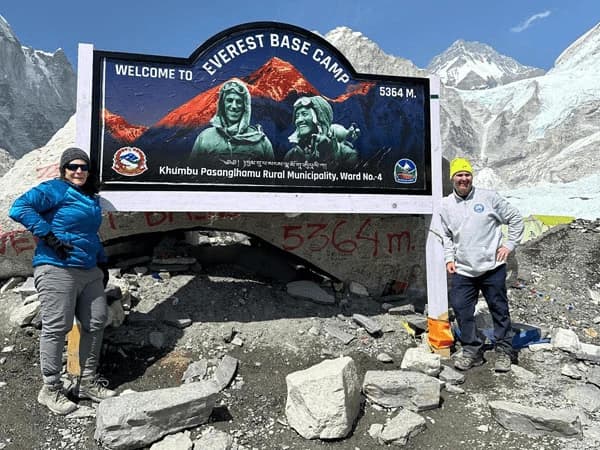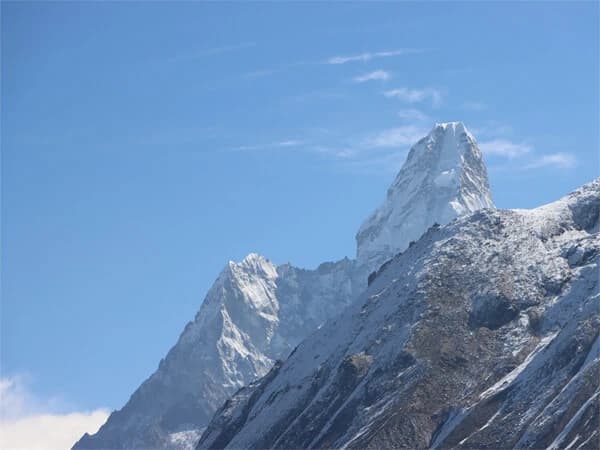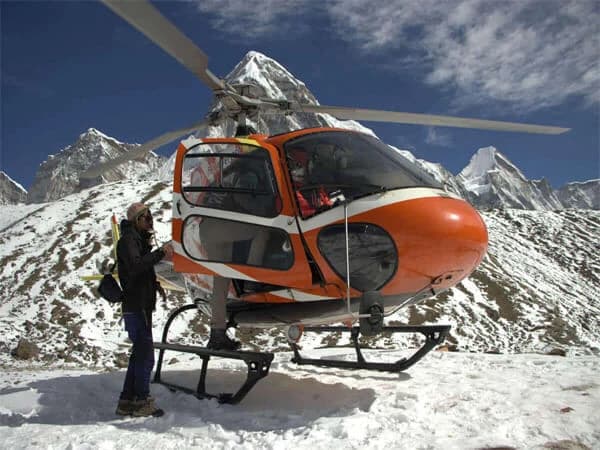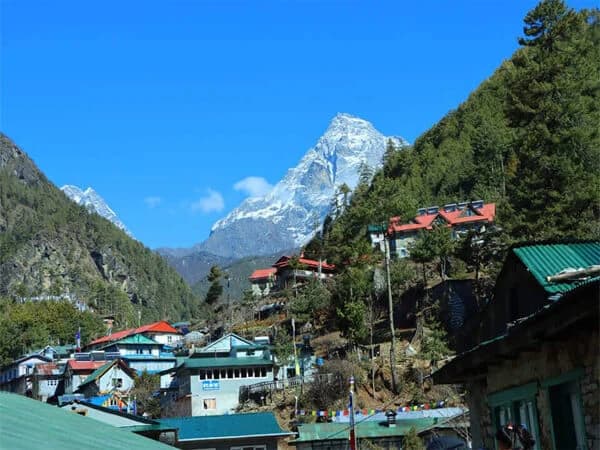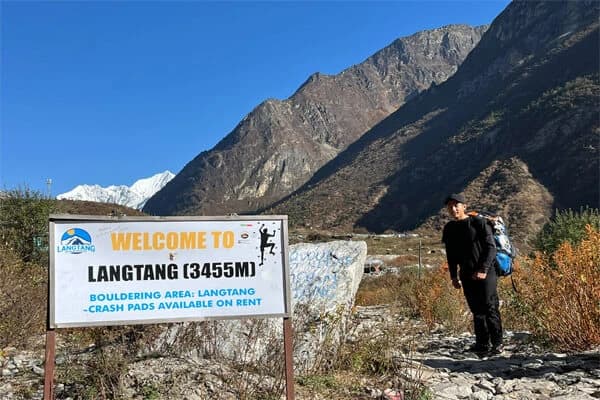The Everest Base Camp (EBC) trek is one of the most adventurous journeys for any trekker. Its amazing landscapes, rich culture, and nearness to the world’s highest peak make it a bucket-list adventure for trekkers from around the globe. But what if you could enhance this already stunning experience with a helicopter return? It offers a breathtaking bird’s-eye view of the Himalayas. It also provides a faster and more comfortable descent after days of trekking uphill.
Best Time for Everest Base Camp Trek with Helicopter Return
Choosing the best time for EBC trek with a helicopter return depends on various factors, including weather conditions, trail crowding, and personal preferences. In this blog, we will explore the pros and cons of trekking in each season, offering trekkers insights to make the best decision.
Everest Base Camp Trek with Helicopter Return in Spring (March to May)
Spring in the Everest region is characterized by moderate temperatures, clear skies, and blooming rhododendron forests. As the snow from winter starts to melt, the trails become accessible, and the landscape begins to transform into a colorful display of flora. For trekkers, this season offers a comfortable climate for walking long hours, while the clear views of Everest and the surrounding peaks create unforgettable memories.
The allure of spring trekking also lies in the vibrant atmosphere. The region comes alive as mountaineering expeditions prepare for their ascent to the summit of Everest, and tea houses along the route bustle with excitement.
When you pair this with an everest base camp trek with a helicopter return, you not only save yourself the strenuous descent but also get the once-in-a-lifetime opportunity to witness the Himalayas from the sky. You will observe an unforgettable perspective of the towering peaks and winding trails below.
Pros of Trekking in Spring with a Helicopter Return
Perfect Weather for Trekking
The temperatures in spring are comfortable, with daytime highs ranging from 12°C to 18°C and nighttime lows from -5°C to -10°C at higher altitudes. This makes the trek pleasant without the extreme cold of winter or the heat of summer. The weather is generally stable, reducing the risk of sudden storms or snowfall, making it a safer time to trek.
Clear Views of the Himalayas
One of the biggest draws of trekking in spring is the breathtakingly clear views of the mountains. Everest and its neighboring peaks stand majestically against blue skies, making for perfect photography and sightseeing.
The clarity of the air also enhances the helicopter flight experience, as you’ll have unobstructed panoramic views of the entire Everest region from the sky.
Beautiful Blooming Landscape
Spring is a time of rejuvenation for the Everest region. As you trek through the lower sections, you’ll be greeted by blooming rhododendrons and lush greenery, contrasting beautifully with the snow-capped peaks above. The colorful scenery adds a unique charm to the trek.
Safer and More Reliable Helicopter Flights
The stable weather conditions in spring make it one of the safest times for helicopter flights. The chances of delays due to bad weather are low, allowing for a smoother and more reliable return journey. The relatively clear skies ensure that your helicopter ride is both scenic and comfortable, with minimal turbulence.
Busy Atmosphere and Sherpa Culture
Spring is peak climbing season for Everest, so trekkers often encounter expeditions preparing for their summit attempts. This adds a layer of excitement and energy to the trek. You’ll also have the opportunity to engage more deeply with Sherpa culture, as the communities along the trail are bustling with trekkers, climbers, and locals alike.
Cons of Trekking in Spring with a Helicopter Return
Crowded Trails
The favorable conditions of spring attract a large number of trekkers, which means the trails can get quite busy. You may find yourself competing for space at tea houses, and the once-remote feeling of the mountains may be dampened by the crowds. The popularity of spring also means that finding accommodation at the best spots along the route can be challenging unless booked in advance.

Higher Costs
Due to the high demand in spring, prices for accommodation, food, and helicopter services tend to be higher than in the off-season. The cost of a helicopter return might increase slightly during this peak season, though the experience is still well worth the investment.
Temperature Fluctuations
While daytime temperatures are generally comfortable, the higher altitudes still experience cold nights, especially in places like Gorak Shep and EBC. Trekkers should be prepared for chilly evenings and early mornings, with appropriate gear. Though rare, some areas may still have lingering snow or ice from the winter season. In March, certain sections of the trail could be more challenging to navigate.
Helicopter Return Experience
A helicopter return in spring offers unparalleled views of the vibrant, snow-capped peaks and blossoming valleys. The stable weather ensures that your return flight is comfortable, with minimal chances of disruption.
Everest Base Camp Trek with Helicopter Return in Summer/Monsoon (June to August)
Trekking to Everest Base Camp (EBC) is a life-changing adventure, and opting for a helicopter return adds a touch of luxury and excitement to the experience. However, when choosing to trek in the summer season, which falls between June and August, you’ll face unique challenges and rewards due to the monsoon weather in Nepal.
Most trekkers prefer spring or autumn. However, the summer offers a distinct opportunity to see the Himalayas in their lush, green beauty, but with potential obstacles. Here’s a comprehensive look at the pros and cons of doing the EBC trek with a helicopter return in summer.
Pros of Trekking EBC in the Summer Season
Lush Green Landscapes
One of the major advantages of trekking in the summer season is the incredible transformation of the landscape. The monsoon rains breathe new life into the region, turning the once rocky and dusty trails into vibrant green paths. Rhododendrons, junipers, and other vegetation flourished during this period, making the trek look amazing through the lower altitudes.
Fewer Crowds
Summer trekking allows for a more peaceful and intimate experience on the trails. With the monsoon season discouraging many trekkers, the popular tea houses and camps along the route are far less crowded compared to the spring and autumn seasons. This gives you more space to enjoy the trek, better access to accommodation, and a more serene environment.
Lower Costs
Due to the reduced number of trekkers, many lodges and teahouses lower their prices during the summer. Helicopter services may also offer more competitive rates due to the decreased demand. If you're trekking on a budget or looking for a more affordable helicopter return option, the summer season provides an opportunity for cost savings.
Cultural Immersion
With fewer trekkers around, summer offers a more personal interaction with the local Sherpa communities. The teahouse owners, guides, and porters will have more time to share stories and insights about their culture, lifestyle, and the mountains. This gives you a deeper connection to the people of the region and a richer cultural experience.
Unique Perspective of the Himalayas
The monsoon clouds may often obscure views of the peaks. However, the times when the clouds clear can reveal the Himalayas glistening under a post-rain glow. The contrast between the lush greenery and the rugged mountains creates an entirely different view compared to other seasons.
Cons of Trekking EBC in the Summer Season
Unpredictable Weather
The biggest downside of trekking to Everest Base Camp in the summer is the unpredictable monsoon weather. The trail below Namche Bazaar is frequently impacted by rain, making it slippery and muddy.
The monsoon also brings occasional thunderstorms, which can create delays and make the trek more physically demanding. The higher altitudes above 4,000 meters experience less rain, but clouds can still obscure views of the iconic peaks, reducing visibility.
Risk of Delays for Helicopter Return
Flying out by helicopter during the summer season can be risky due to frequent cloud cover and rainstorms. Helicopters are highly dependent on weather conditions, and the poor visibility associated with the monsoon increases the likelihood of flight cancellations or delays. This is a significant factor to consider, as it can impact your travel plans, especially if you're on a tight schedule.
Leeches and Insects
The monsoon brings out an abundance of leeches and other insects, particularly in the lower altitudes of the trek. Trekking through damp forests can lead to encounters with these pests, which can be an uncomfortable experience for some. Leeches are more of an annoyance than a real danger. Proper gear like gaiters and insect repellent are necessary to minimize their impact.
Slippery Trails and Increased Difficulty
With the heavy rainfall comes slippery and muddy trails, especially in the lower regions. The wet conditions make it easier to slip, which can slow your pace and increase the physical demands of the trek. The higher you go, the better the conditions tend to be, but getting to the higher altitudes can be more challenging due to these trail conditions.
Limited Views of Mountains
Though the summer season can bring short windows of clear skies, the monsoon generally covers the Everest region in clouds. This can mean fewer opportunities to enjoy those iconic mountain views that draw trekkers to the region. For many, the lack of clear visibility of Everest and other peaks may be disappointing, especially if scenic views are a priority.
Helicopter Return Experience:
Flying in the monsoon can be challenging. Visibility might be poor due to cloud cover, and weather conditions may lead to delays or cancellations. However, if you’re lucky with a clear day, you’ll witness the beauty of the Himalayan rain-soaked greenery from above, a view that’s rarely seen during other seasons.
Everest Base Camp Trek with Helicopter Return in Autumn (September to November)
In Nepal, autumn follows the monsoon season. The trails are refreshed, the skies are clear, and the mountains stand crisp and tall against the blue sky. The Everest region is at its best, with unobstructed views of snow-capped peaks and a comfortable trekking climate. Moreover, a helicopter return allows trekkers to avoid the long descent, providing a spectacular aerial view of the Himalayas and a quick, luxurious end to the adventure.
Pros of EBC Trekking with Helicopter Return in Autumn
Perfect Weather Conditions
One of the biggest advantages of trekking to Everest Base Camp in autumn is the stable and pleasant weather. Daytime temperatures range from 10°C to 15°C, making the trek enjoyable without extreme heat or cold. Nights are cooler but manageable with proper gear. The absence of monsoon rains and pre-winter snow ensures dry trails, making it easier to trek through the rugged terrain.
Helicopter Safety: Clear skies during this season also make it an ideal time for helicopter flights. With fewer chances of weather-related delays, your return to Kathmandu is likely to be smooth and punctual.
Stunning Mountain Views
Autumn provides some of the clearest views of the Himalayan peaks, including Mount Everest. The post-monsoon air is clean, offering trekkers unobstructed vistas of the surrounding mountains. These clear conditions extend to the helicopter flight as well. You will have an awe-inspiring aerial journey as you fly back over the valleys and ridges you just trekked.
Aerial Panorama: The helicopter return offers a unique perspective, allowing you to witness the grandeur of Everest and other peaks from above. You’ll pass over deep valleys, emerald forests, and glacial rivers, all while soaring at eye level with some of the world’s tallest mountains.
Festive Atmosphere
Autumn coincides with some of Nepal’s biggest festivals, including Dashain and Tihar. As you trek through the villages on your way to EBC, you’ll experience the vibrant Sherpa culture and witness these festivals in their full glory. This adds a rich cultural layer to your adventure, making the trek more than just a physical journey but a cultural immersion as well.

Local Hospitality: With fewer trekking groups compared to spring, you might enjoy more personal interactions with locals, experiencing their traditions and way of life.
Comfortable Trekking Experience
The moderate temperatures in autumn make the trekking experience more comfortable. You won’t have to deal with the intense cold of winter or the sticky heat and rain of summer. This is especially important on a high-altitude trek like EBC, where fluctuating temperatures can add to the physical challenges.
Well-equipped Tea Houses: During autumn, most tea houses along the trekking route are open and well-stocked, offering good food and comfortable lodging. Since autumn is a busy season, tea houses are prepared for trekkers, ensuring better service and availability.
Cons of EBC Trekking with Helicopter Return in Autumn
Crowded Trails
One of the main downsides of trekking in autumn is that it’s a peak season. With so many trekkers choosing this time for their EBC adventure, the trails can become crowded. This means you’ll need to book accommodations in advance, and tea houses may feel busier than during the off-season.
Helicopter Demand: The demand for helicopter returns also rises during autumn, meaning you may need to secure your booking early. While Nepal Trekking Routes ensures high-quality service, peak season can sometimes lead to minor delays or waiting times for helicopter availability.
Higher Costs
As with any peak season, prices for accommodation, food, and helicopter services tend to increase during autumn. While the experience is worth it, trekkers on a tighter budget should be aware that costs are generally higher than in other seasons.
Helicopter Price Surge: Helicopter services are in high demand in autumn, and this could reflect higher costs compared to off-season trekking. Planning your budget accordingly is essential to avoid any last-minute surprises.
Challenging Logistics
Although autumn weather is generally stable, occasional late monsoon rains in early September or early snowfall in late November can disrupt the logistics of your trek or helicopter flight. While these occurrences are rare, they can lead to brief delays in trekking or flights.
Crowded Tea Houses: You may also experience full bookings in tea houses, especially around popular stops like Namche Bazaar and Dingboche. Advanced reservations through agencies like Nepal Trekking Routes can help solve this issue.
Helicopter Return Experience:
In autumn, a helicopter return is magical. You’ll glide over valleys illuminated by the post-monsoon sunshine, with crisp mountain air filling your senses. The clarity of the skies provides a full, uninterrupted view of Everest and its neighboring peaks. This season ensures a smooth and awe-inspiring helicopter journey back to Kathmandu. You may enjoy Everest Base Camp Helicopter Tour as well.
Everest Base Camp Trek with Helicopter Return in Winter (December to February)
The Everest Base Camp (EBC) trek in winter is often overlooked, with most trekkers opting for the more popular spring and autumn seasons. However, for those who crave solitude, snow-capped landscapes, and a unique challenge, winter trekking in the Everest region offers an exceptional adventure.
Adding a helicopter return to this already exciting experience can make it even more memorable. It allows you to bypass the long descent and enjoy spectacular aerial views of the snow-covered Himalayas. But trekking in winter comes with its own set of challenges and advantages.
Let’s dive into the pros and cons of trekking to Everest Base Camp with a helicopter return during the winter season.
Pros of Trekking to Everest Base Camp in Winter
Fewer Crowds
Winter is the off-season for trekking, which means far fewer trekkers on the trails. Unlike the crowded paths of spring and autumn, winter offers a more tranquil, peaceful trekking experience. You can enjoy the solitude, take in the pristine environment without interruption, and have the mountains nearly to yourself. For those who value isolation and a personal connection with nature, this is the perfect time to visit.
Stunning Snowy Landscapes
The Himalayas transform into a breathtaking winter wonderland during the colder months. Snow blankets the peaks and valleys, creating a serene, untouched beauty that you won’t find in other seasons. This natural splendor makes the trek even more magical, as the towering peaks appear sharper against the clear, crisp skies.
Clear Skies and Excellent Visibility
Winter generally brings clearer skies, especially after snowfall. The cold, dry air can create some of the best visibility of the year, providing perfect conditions for panoramic views of Everest, Lhotse, Nuptse, and Ama Dablam. For photography enthusiasts, this season offers a great opportunity to capture stunning shots of the Himalayan range.
Helicopter Return: A Unique Winter Aerial View
While the trek back to Lukla after reaching Everest Base Camp can be long and arduous, opting for a helicopter return in winter is both time-saving and visually spectacular. You’ll get a bird’s-eye view of the snow-covered mountains, frozen rivers, and peaceful villages, all under the bright winter sky. Helicopter flights during winter tend to be smoother because the cold air improves flight conditions.
Lower Costs
Since winter is the low season for tourism in Nepal, you’ll find that the cost of accommodation, food, and even helicopter services can be more affordable compared to the busier months. Many lodges also offer discounts to attract the few trekkers who brave the winter cold.
Cons of Trekking to Everest Base Camp in Winter
Harsh Cold Temperatures
The most significant downside of winter trekking is the cold. Daytime temperatures at lower elevations can range from 0°C to 10°C, but as you ascend, it can drop to -15°C or even lower at night. At higher altitudes, such as Gorak Shep and EBC, temperatures can plummet to -20°C or below. Trekking in such extreme cold requires high-quality gear, proper layering, and mental preparedness to endure the harsh conditions.
Snow and Ice on the Trails
The trails are often covered in snow and ice during the winter months. The trek is more difficult and potentially hazardous. Some sections of the path may be slippery or blocked by snow, requiring caution and sometimes technical gear like microspikes. The risk of injury or altitude sickness can increase in such conditions. So, it is essential to trek with an experienced guide.
Limited Accommodation and Facilities
Many tea houses and lodges close during the winter season due to low tourist demand and harsh weather. While some remain open, the options for accommodation, especially at higher elevations, can be limited. The open lodges may also have fewer amenities, and in some cases, heating is minimal, which can make the nights even more challenging.
Shorter Days
The days are shorter in winter, with fewer daylight hours for trekking. This means you’ll need to start your days early to make the most of the limited sunlight. Shorter days can also limit your time to rest and recover after a long day of trekking, and night temperatures drop dramatically as soon as the sun sets.
Helicopter Delays Due to Weather
Although winter skies can be clear, unpredictable snowstorms can cause flight delays or cancellations. If the weather turns bad, your helicopter return could be postponed, which may force you to extend your stay in higher-altitude regions. While reputable agencies like Nepal Trekking Routes prioritize safety and provide alternative plans in such cases, it’s still a factor to consider when choosing this option.
Helicopter Return Experience:
Winter helicopter returns offer stunning views of the snow-blanketed Himalayas. However, the risk of flight delays due to snowfall is higher. If timed right, though, a helicopter ride in winter offers a serene and rare view of the Everest region.
Key Considerations for Choosing the Right Season
Weather Conditions:
Each season brings different weather patterns. If you prefer stable, clear skies and good trekking conditions, spring and autumn are your best options. For those who enjoy a quieter trail or lush, green landscapes, summer and winter offer their charm.
Crowd Levels:
If you prefer trekking with fewer people around, consider winter or the monsoon season. However, you’ll need to be prepared for harsher weather conditions.
Helicopter Safety:
Helicopter flights are more reliable in the spring and autumn when the weather is more stable. Summer brings challenges due to cloud cover and rain, while winter flights can be delayed by heavy snowfall.
Costs:
Prices tend to rise during peak seasons (spring and autumn). If you're looking for a more budget-friendly trek, consider trekking during off-peak times like winter or monsoon.
Conclusion
The best time to trek Everest Base Camp with a helicopter return depends on your preferences. Spring and autumn offer stable weather, clear skies, and vibrant landscapes making them ideal for most trekkers. Winter offers solitude and stunning snow-covered views but demands more preparation, while summer provides lush scenery with the challenge of monsoon rains.
Nepal Trekking Routes is an excellent choice, offering expert guidance and seamless helicopter returns, ensuring safety and a memorable experience in any season. Their local knowledge and customized packages make your Everest adventure both enjoyable and hassle-free.


